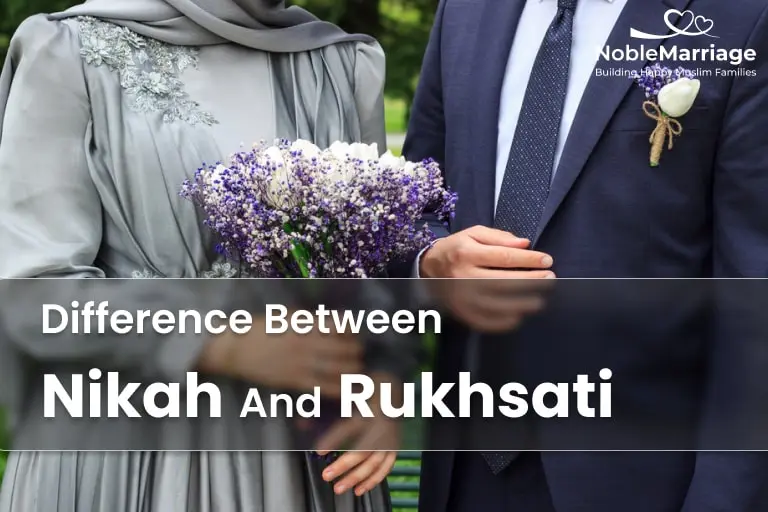Key Takeaways:
- Nikah: Formal marriage contract in Islam, creating an agreement recognized by Allah and legally in the residing country.
- Rukhsati: Event following Nikah, symbolizing the bride’s departure to the husband’s home, marked by emotional significance.
- Differences: Timing, purpose, prayers, and consummation distinguish Nikah and Rukhsati.
- Cultural and Sunnah Aspects: Variances in traditions, modesty, and wedding ceremonies, emphasize the importance of a humble marriage.
- Rukhsati Timing: Recommended to conclude soon after Nikah, following Sunnah practices.
- Other Events: Khitbah, Walima, and additional cultural celebrations contribute to the rich tapestry of Muslim marriages.
Marriage in Islam, a sacred institution, involves distinctive events like Nikah and Rukhsati. This exploration delves into their differences, cultural nuances, and the significance of these pivotal moments.
For this article, we will dive deep into the Nikah and Rukhsati, highlight the differences, and also highlight some of the other events that make marriages such an important occasion in a Muslim’s life.
What is Nikah in Islam?
Muslim Life Partner?
The Nikah is the formal marriage contract in Islam. The event is carried out to create an agreement between the bride and the groom in the eyes of Allah (SWT). It is also meant to legally recognize the union between the two in whichever country they reside in.
Remember that Allah surely knows best. As the quote below implies, he has destined a partner for you:
“And We created you in pairs.” Quran (78:8)

What is Rukhsati in Islam?
Rukhsati comes after the nikah. This event is the sending off of the bride, as she departs from her home for her husband’s home. It tends to be an emotional moment and marks a shift in the bride’s life as she becomes the responsibility of the husband.
Key Differences Between Nikah and Rukhsati
There are a lot of basic elements which make Nikah and Rukhsati different. Along with the timing and the purpose, the prayers to be said during each event are also different. The following table highlights at a glance the major differences.
| Nikah | Rukhsati | |
| Timing | After the engagement (khithbah) | After the nikah and the wedding ceremony |
| Purpose | To make the marriage official | To formally send off the bride |
| Consummation | Can be done after the Nikah but must after Rukhsati | Should be done soon after bride arrives |
| Dawa and Prayers | Mandatory, led by the Imam or scholar overseeing the ceremony There are specific verses and prayers for the Nikah | Considered sunnah, the groom and bride should pray 2 rakah of nafl before consummation |
The Different Details of the Nikah and the Rukhsati
The Nikah takes place near the start of a marriage, while the Rukhsati takes place towards the end. Not only are the timing and purpose different, the things that take place before, during, and after both events also vary.
Remember that they are both important functions in Islam, and need to be done in a certain manner while maintaining fixed practices.
| Nikah | Rukhsati |
| Consent Mahr Prayers Declaration of the Marriage | Presence of bride’s family Worthy welcome Prayers Consummation |
What Happens at the Nikah?
A nikah ceremony has to be carried out by an Islamic scholar, or an Islamic authority figure. This person has to be recognized by the government of the country the nikah is happening in.
The key parts of the Nikah include:
- Agreeing to the Marriage and consent between the bride and the groom
- Agreeing on the Mahr (gift given from the groom to the bride)
- Prayers and Sermons
- Declaring the Marriage
Once the prayers and sermons are over with and the bride and groom have given their hand to each other, the marriage is finally declared and announced.
What Happens at the Rukhsati?
This by far is the most emotional moment during a marriage. During the rukhsati ceremony, a bride has to endure the heartbreak of leaving her family behind, and move to a new home.
Even though there are customs and practices that vary from country to country, the significance of the event remains the same.
Key parts of the Rukhsati include:
- Presence of the bride’s family
- A Warm Welcome
- Consummation
- Prayers
Sunnah and Cultural Differences
There are also significant differences between Nikah and Rukhsati when it comes to both culture and sunnah.
One cultural tradition nowadays for example is having an extravagant wedding. But it is actually sunnah to keep the entire marriage ceremony as humble as possible. Printing cards, hosting large events, is something that is a personal choice, and usually done in this day and age for societal reasons. Rather, it is recommended in Islam to spend and do things that will directly bring blessings.
But to each their own. A wedding is still an important event in the life of a Muslim and we don’t have the right to judge.
Sunnah Way
Location
An important sunnah is if you have the Nikah in a mosque. It is considered an immense blessing.
Mahr
The mahr is also an interesting point of attention in Islam. It is sunnah to give the mahr immediately, yet it can also be given later as long as agreed upon. It is also sunnah for the bride to reduce the mahr value to something not difficult for the groom.
A mahr can also be avoided altogether if the groom and the bride agree upon it. Remember that the mahr is there as a protection for the bride in the case of divorce. Financial protection is also a responsibility of the groom, as in Islam men are considered the protectors of women, as shown in this verse (from The Clear Quran, Dr. Mustafa Khattab):
“Men are the caretakers of women, as men have been provisioned by Allah over women and tasked with supporting them financially. And righteous women are devoutly obedient and, when alone, protective of what Allah has entrusted them with.” (Quran, 4:34)
Timing of the Rukhsati
Rukhsati should be concluded as soon as possible after the Nikah. This is considered Sunnah.
Prayers
Prayers during the Nikah is fard. There should be prayers during the Rukhsati as well, and it is Sunnah for the husband and wife to pray two rakahs of nafal before consummation. Another important Sunnah is to of course ensure a worthy welcome for the bride.
Among other things, avoiding “un-Islamic” things is also recommended. Wearing modest clothing, feeding the poor, and if possible doing the Nikah during the month of Shawwal is Sunnah.
Cultural Way
Culturally, some practices of the Nikah can vary. In Bangladesh and Pakistan for example, it is also normal to have a lot of people to be present from both the groom and bride’s family during the event. In some regions, especially those under Shahriah law, the groom and the bride are kept completely separate until they’re married.
Cultural Customs
In some regions the mother-in-law will feed the bride during the Rukhsati. There may even be a procession with expensive cars and music during the welcome as well. In Middle Eastern nations, there are even gun salutes during the Rukhsati. These are all cultural customs, but the warm welcome is something that is common and is actually sunnah.
Attire
Both events even have different kinds of clothing as you cross borders. In the Indian subcontinent for example, wearing jewelry and large ethnic gowns is fairly common for the bride during the Nikah. In the Middle East however, women may wear a more western gown during their weddings.
Timing
As mentioned before, Rukhsati should be concluded as soon as possible after the Nikah unless there is a valid reason not to. There are both cultural and religious aspects to it. During olden times, it was normal for Nikah to be done even when the bride and the groom were children and the Rukhsati was delayed until they were of age so that the groom could have properly assumed his responsibilities as a husband, and vice versa.
One notable case was the Nikah between our Prophet Hazrat Mohammad (SAW) and Hazrat Ayesha RaziAllah Ta‘ala Anha. It took place when Hazrat Ayesha was only 6 and the Rukhsati took place years after when she was of age.
Nowadays, it’s normal for the Rukhsati and the other series of events to happen even a year after the Nikah itself. There really is no exact time range, but it is so that the marriage is made complete.
Other Events of Marriage
| Event flow of a Typical Muslim Marriage Ceremony |
| Khitbah Nikah Rukhsati Walima |
A Muslim marriage is a long series of celebrations wherever you are in the world. The above four events are the most common. In addition to these there are also different events from region to region. For example in India and Bangladesh you may have an event called the haldi. In Pakistan you may have sangeet.
The engagement or as it is known as the khitbah in Islam, is when the two families come together to decide upon marriage between the potential couple. This event may also include discussions about the mehr and timing of the Nikah.
There is also the reception, or what is known as Walima in Islam. This happens after the Rukhsati and is an event hosted by the groom’s side, to introduce the married couple to the world. This is not mandatory but rather sunnah.
In some countries, there may be another event after the Nikah. It usually takes place right before the Rukhsati. In Bangladesh for example it is called biye. At the end of the biye the bride is sent off to her new home.
There are other points we also have to keep in mind. As you read this you may be asking, if Rukhsati does not happen immediately then does nikah count as being married? In the eyes of the lord yes of course it does. The only difference being is that the bride is waiting to be taken to her new home.
FAQs:
What is the difference between Walima and Rukhsati?
The walima is the reception after the rukhsati. Rukhsati is simply the event that formally welcomes the bride to her new home.
Can you have a Nikah without parents?
Most scholars agree that there has to be a male legal guardian present.
Can you do Nikah on video call?
Yes you can, although it may not be legally recognized in the country you reside in.
How long can you delay Rukhsati after Nikah?
There is no fixed time, but you should finish the rukhsati as soon as you can after the nikah unless there are valid reasons not to.
Is it necessary to consummate a marriage in Islam?
Yes it is. Intimacy and physical relations between husband and wife is part of the commitment made during the Nikah.
Final Thoughts
By now the differences between nikah and rukhsati are very obvious, and each event has its share of elements that make them unique. The differences can be both cultural and religious. Some things are fard while others are sunnah. What makes Nikah and Rukhsati significant is that the two events are the official start of a Muslim couple’s marriage and part of one of the holiest aspects of Islam.
References:
- https://corpus.quran.com/translation.jsp?chapter=78&verse=8
- https://islamawakened.com/quran/4/34/
- https://islamqa.org/
- What To Include On Wedding Invitation? Expert Guide - November 9, 2024
- What Is a Split Wedding? - October 15, 2024
- How To Ask For Money Instead of Gifts For Wedding? - October 12, 2024
